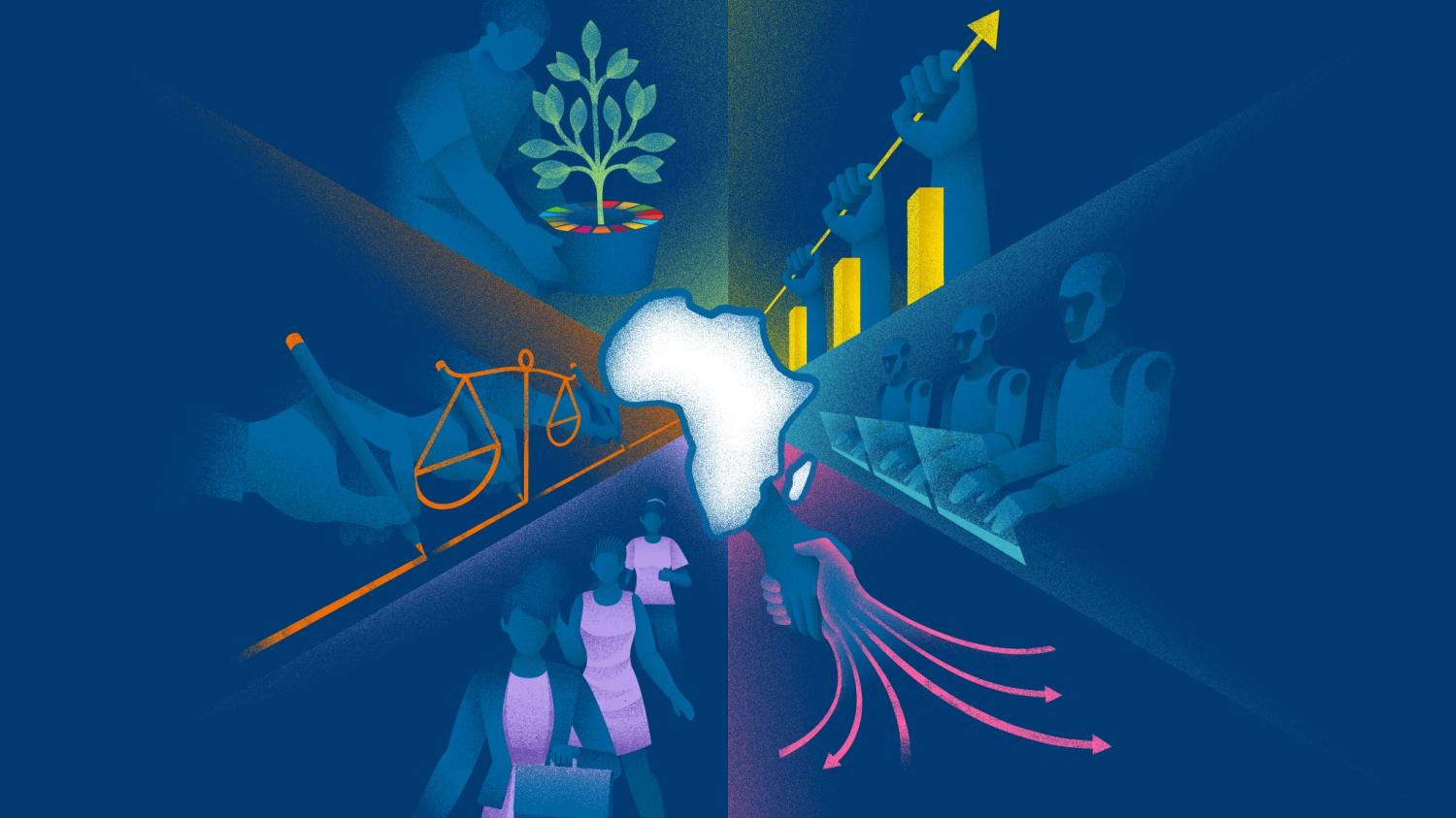This viewpoint is part of Chapter 2 of Foresight Africa 2025-2030, a report with cutting-edge insights and actionable strategies for Africa’s inclusive and sustainable development in the run-up to 2030. Read the full chapter on the Sustainable Development Goals.
Through the use of these strategies, Africa can not only achieve the SDGs and Agenda 2063 goals—it can exceed them.
In the year 2025, Africa is focusing on the dual aspirations of the targets set out by the African Union’s Agenda 2063 and the Sustainable Development Goals (SDGs).1 Currently, Africa has a long way to go to achieve the SDGs by 2030.2 In an effort to accelerate progress toward achieving these two sets of important intergovernmental objectives, the African Union Development Agency created the New Partnership for Africa’s Development (AUDA-NEPAD) in 2001 with the intention of initiating programs that promote sustainable development and accelerate inclusive economic growth.3 Since its genesis, AUDA-NEPAD has engaged in a systematic deployment of initiatives that affect various parts of African society to accelerate progress. While there are still many outstanding challenges, there are several areas that have been successful.
One such success story occurred when the Programme for Infrastructure Development in Africa (PIDA) enhanced intra-Africa trade through the construction of the Kazungula Bridge, which links Botswana and Zambia. Both countries have experienced an increase in trade volumes since the bridge’s inauguration, and the time to cross the border decreased from days to minutes.4 Additionally, PIDA has supported over 100 priority infrastructure projects which have collectively contributed to reducing Africa’s infrastructure financing gap, currently estimated at $68 to $108 billion annually.5
One area where many nations on the continent are still falling behind, however, is in health care. Facilities are outdated, understaffed, and under-resourced. Through the African Medicines Regulatory Harmonization program and the Pharmaceutical Manufacturing Plan for Africa, AUDA-NEPAD has established local manufacturing plants across Africa. Notable examples include the Aspen Pharmacare facility in South Africa, which produces over 300 million doses of vaccines annually, and the Dangote Petrochemical Manufacturing Complex in Nigeria, which provides raw materials used in the manufacturing of generic drugs. Facilities such as these are necessary for Africa to reduce its reliance on imported pharmaceuticals, which are too expensive for many patients and hospitals to provide in sufficient supply.6
Nations across the continent can also benefit from increased economic engagement from women and youth. Programs focused on women and youth empowerment provide the skills necessary for these groups to enter the formal economy at levels that have yet to be seen. AUDANEPAD’s 100,000 Micro, Small, and Medium Sized Enterprises Initiative has provided business and digital skills, through vocational training programs such as the Skills Initiative for Africa, to over 2 million entrepreneurs, with 60% of the beneficiaries being women and/or youth.7
Meeting both Agenda 2063 and the SDGs will rely heavily on Africa’s ability to transform to a digital economy. Data-driven decisionmaking is one way to increase effectiveness and efficiency of policies. The Agenda 2063 Digital Platform and Dashboard, developed and operated by AUDA-NEPAD, enables real-time data analytics and evidence-based decisionmaking and helps countries across Africa monitor their progress on metrics from both initiatives while also identifying future challenges.8
However, these projects have a long way to go to address the enormous gap between current reality and the SDGs. Economic vulnerabilities exacerbated by global inflationary pressures and limited fiscal space have resulted in anemic GDP growth, averaging 3.2% continentwide in 2023,9 falling well short of the 7-10% annual growth required to meet Agenda 2063 targets.10 Annual financing has been roughly $402 billion below what is needed.11 More needs to be done to create a development environment that maximizes every dollar spent to reach the highest number of people in need.
Climate change has exacerbated the costs associated with development. Climate adaptation methods are still lagging what is needed, with an expected necessary expenditure of $30- 50 billion annually over the next decade to match the adaptation needs of the continent.12
Climate disasters such as droughts, flooding, and rising sea levels have already led to increased migration and poverty.13
AUDA-NEPAD’s ability to provide development programming is reliant on funding from donor countries. Delays in these contributions have often left the organization incapable of scaling these initiatives to meet a greater proportion of those in need. Long-term strategies are often halted due to financial constraints.14 This is further complicated by diverging goals between member states, the African Union Commission, and Regional Economic Communities.15
Even so, there are lessons to be learned from AUDA-NEPAD’s successes and struggles. One way to overcome diverging goals is to create initiatives through strategic partnerships. Partnerships with the stakeholders mentioned above have often led to the unlocking of funds on projects with which they are affiliated.16 Additionally, they provide a level of technical expertise that enhances the project outcomes.
Furthermore, the enhanced monitoring framework under the Second Ten-Year Implementation Plan (STYIP) aims to underscore the importance of data-driven decisionmaking. These include an enhanced Monitoring and Evaluation Framework for Agenda 2063, a Core Indicator Handbook providing granular profiles of the STYIP, and a data-entry, analysis, and reporting template that aligns both the STYIP and the SDGs. These protocols have been developed from lessons learned from the First Ten-Year Implementation Plan’s successes and failures.17
As 2025 unfolds, collective priorities should be set that push all of Africa toward achieving the SDGs and Agenda 2063 priorities. We propose the following:
- Africa must work toward financial independence by mobilizing domestic financing.18 Relying on the domestic bond market to prop up strategic markets could provide a more sustainable approach to long-term goals such as transforming into a green economy. Green bonds attract investors who are environmentally conscious while supporting green initiatives such as renewable energy. Kenya and South Africa have already begun exploring these opportunities.19
- More countries need to turn toward data-driven decisionmaking and digitization of government. The Agenda 2063 Digital Platform should be frequently utilized by policymakers across Africa to maximize their impact. Digitizing government services is another way that governments can reach the highest number of people. Countries like Rwanda, with its digital-first approach, demonstrate how e-governance enhances public service delivery, reduces corruption, and boosts citizen trust.20
- Investments in climate resiliance are vital to the health and well-being of all Africans. Investments in renewable energy, sustainable agriculture through the Africa Fertilizer and Soil Health Action Plan, and disaster risk reduction platforms are building Africa’s capacity to adapt to climate challenges.21 AUDA-NEPAD recently launched the Africa Disaster Risk Management and Recovery Platform, which provides solutions by mobilizing financial and technical resources to address climate-related needs.22 2025 will provide nations the first chances to leverage this resource to its fullest.
- The African Continental Free Trade Area has provided a framework for improved regional integration.23 Infrastructure projects, trade, and knowledge-sharing are made feasible through the Agreement. Continued up-scaling of such initiatives is necessary for Africa’s development.
Through the use of these strategies, Africa can not only achieve the SDGs and Agenda 2063 goals—it can exceed them. Strategic partnerships, particularly through the Africa Team Program Framework and regional delivery offices, will be key to accelerating impact. Simultaneously, AUDA-NEPAD’s focus on innovative financing mechanisms—such as blended finance and green bonds—promises to unlock new resources for sustainable development. The “Africa We Want” is not just a dream; it is a collective commitment.
-
Acknowledgements and disclosures
We extend our gratitude to Nichole Grossman, Research Analyst at Brookings Africa Growth Initiative, for her outstanding research and editorial support.
-
Footnotes
- Lina Henao, Mary Hui, and Gordon Shaw, “Africa 2030: How Africa Can Achieve the Sustainable Development Goals” (Kigali: The Sustainable Development Goals Center for Africa, November 2017), https://sdgcafrica.org/wp-content/ uploads/2018/03/SDG_2030_Nov_2017.pdf; “Agenda 2063: The Africa We Want” (Addis Ababa: African Union Commission, September 2015), https://au.int/sites/default/files/documents/36204-doc-agenda2063_popular_ version_en.pdf.
- Jeffrey D. Sachs, Guillaume Lafortune, and Grayson Fuller, “The SDGs and the UN Summit of the Future. Sustainable Development Report 2024” (Dublin: Dublin University Press, 2024), https://www.tara.tcd.ie/handle/2262/108572.
- “African Union Development Agency-NEPAD (AUDA-NEPAD),” Africa Renewal, accessed December 18, 2024, https:// www.un.org/africarenewal/african-union-development-agency-nepad-auda-nepad.
- Gertrude Kitongo and Tom Page, “How a $260M Bridge Negotiated Africa’s Most Unusual Border,” CNN, August 22, 2022, https://www.cnn.com/2022/08/17/africa/kazungula-bridge-botswana-zambia-spc-intl/index.html.
- “Afria’s Infrastructure: Great Potential but Little Impact on Inclusive Growth” (Abidjan: African Development Bank Group, 2018), https://www.afdb.org/fileadmin/uploads/afdb/Documents/Publications/2018AEO/African_Economic_ Outlook_2018_-_EN_Chapter3.pdf.
- Tefo Pheage, “Dying from Lack of Medicines: Encouraging Local Production, Right Policies the Way Out,” Africa Renewal (blog), November 25, 2016, https://www.un.org/africarenewal/magazine/december-2016-march-2017/ dying-lack-medicines; Aderaw Yenet, Getinet Nibret, and Bantayehu Addis Tegegne, “Challenges to the Availability and Affordability of Essential Medicines in African Countries: A Scoping Review,” ClinicoEconomics and Outcomes Research: CEOR 15 (June 13, 2023): 443–58, https://doi.org/10.2147/CEOR.S413546.
- “Projects,” SIFA Skills Initiative for Africa, accessed December 18, 2024, https://skillsafrica.org/projects; “The 100,000 MSMEs Initiative African Union,” accessed December 18, 2024, https://au.int/en/articles/100000-msmes-initiative.
- “Agenda Dashboard v2,” AUDA-NEPAD accessed January 7, 2025, https://nepad.org/agenda-dashboard-v2.
- “African Economic Outlook 2024: Driving Africa’s Transformation The Reform of the Global Financial Architecture” (Abidjan: African Development Bank Group, June 6, 2024), https://www.afdb.org/sites/default/files/2024/06/06/ aeo_2024_-_chapter_1.pdf.
- “Sustain Minimum Growth Rate of 7-10% of GDP to Achieve Inclusive Growth and Sustainable Development in Africa, Experts Say at AU Summit,” African Development Bank, February 19, 2023, https://www.afdb.org/en/news-and-events/ press-releases/sustain-minimum-growth-rate-7-10-gdp-achieve-inclusive-growth-and-sustainable-development-africaexperts-say-au-summit-5915.
- “African Economic Outlook 2024 | Driving Africa’s Transformation: The Reform of the Global Financial Architecture” (Abidjan: African Development Bank, 2024), https://www.afdb.org/en/documents/african-economic-outlook-2024- highlights.
- Africa Faces Disproportionate Burden from Climate Change and Adaptation Costs,” World Meteorological Association, September 2, 2024, https://wmo.int/news/media-centre/africa-faces-disproportionate-burden-from-climate-changeand-adaptation-costs.
- Simeon K. Ehui and Kanta Kumari Rigaud, “Climate Migration—Deepening Our Solutions,” Brookings (blog), March 17, 2022, https://www.brookings.edu/articles/climate-migration-deepening-our-solutions/.
- Temiloluwa Anne Ojo-Lanre and Akeem Amodu, “NEPAD and Right to Development in Africa: A Critical Review,” Kashere Journal of Politics and International Relations 2, no. 2 (September 3, 2024): 407–18.
- Temiloluwa Anne Ojo-Lanre and Akeem Amodu , “NEPAD and Right to Development in Africa: A Critical Review.”
- “African Union Development Agency-NEPAD”; “AUDA-NEPAD and EU Join Forces for Africa’s Future,” AUDA-NEPAD October 17, 2024, https://www.nepad.org/news/auda-nepad-and-eu-join-forces-africas-future; “AUDA-NEPAD and Mercy Ships International Forge Strategic Partnership to Strengthen Health Systems for Safe Surgical Care in Africa,” AUDA-NEPAD, December 17, 2024, https://www.nepad.org/news/auda-nepad-and-mercy-ships-international-forgestrategic-partnership-strengthen-health; “AUDA-NEPAD Renews MoU with UN World Tourism Organization,” AUDANEPAD, June 15, 2021, https://www.nepad.org/news/auda-nepad-and-mercy-ships-international-forge-strategicpartnership-strengthen-health; “Fostering Synergy: Advancing Africa’s Development Agenda through Collaboration,” AUDA-NEPAD, February 27, 2024, https://www.nepad.org/news/fostering-synergy-advancing-africas-developmentagenda-through-collaboration; “NEPAD / AU Development Agency,” African Union, accessed December 18, 2024, https://www.un.org/africarenewal/african-union-development-agency-nepad-auda-nepad.
- “Decade of Accelerated Implementation: Second Ten-Year Implementation Plan 2024-2033,” Agenda 2063 (Addis Ababa: African Union, 2024, https://www.nepad.org/publication/agenda-2063-second-ten-year-implementationplan-2024-2033.
- “Advancing Agenda 2063: AU Considers Feasibility of Development Fund,” AUDA-NEPAD, July 2024, https:// www.nepad.org/news/advancing-agenda-2063-au-considers-feasibility-of-development-fund; “PIDA’s Decade of Transformation: AUDA NEPAD Paving the Way for Africa’s Prosperous Future,” AUDA-NEPAD, October 9, 2023, https:// www.nepad.org/news/pidas-decade-of-transformation-auda-nepad-paving-way-africas-prosperous-future.
- Nicholas Mukono, “Forecasting the Term Structure of Government Bonds in Kenya,” University of Nairobi (thesis), 2018.; Chege Kamenju, “Effect of Macroeconomic Factors on the Development of Bond Market in Kenya,” University of Nairobi (thesis), 2018.
- “Rwanda Digital Transformation: Charting the Future of Global Data Access,” World Economic Forum, C4IR: Impact on the Ground (blog), Setpember 2024, https://cdn.jwplayer.com/previews/WoBLOioi-ncRE1zO6.
- “African Fertilizer and Soil Health Action Plan: 2023-2033,” (Addis Ababa, Ethiopia: African Union, n.d.).
- “A New Era in Disaster Management: Launch of the African Disaster Risk Management and Recovery Platform,” AUDANEPAD, November 15, 2024, https://www.nepad.org/news/new-era-disaster-management-launch-of-african-disasterrisk-management-and-recovery.
- “AfCFTA Update November 2024,” International Trade Administration, Market Intelligence (blog), November 1, 2024, https://www.trade.gov/market-intelligence/afcfta-update-november-2024.
The Brookings Institution is committed to quality, independence, and impact.
We are supported by a diverse array of funders. In line with our values and policies, each Brookings publication represents the sole views of its author(s).






Commentary
Delivering the Africa of the future: AUDA-NEPAD’s role in achieving Agenda 2063 and the SDGs
March 20, 2025